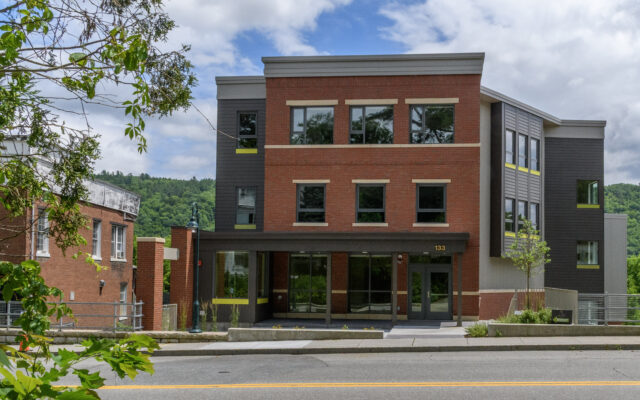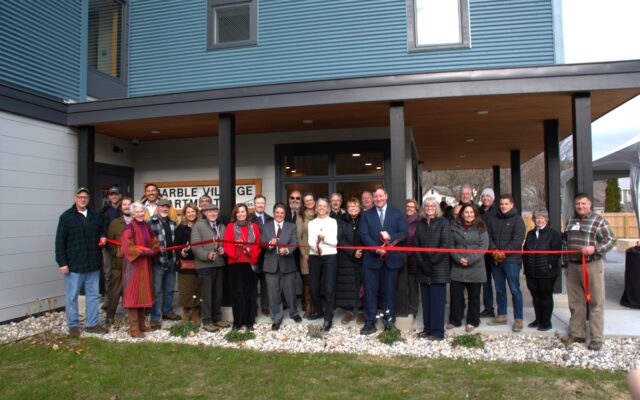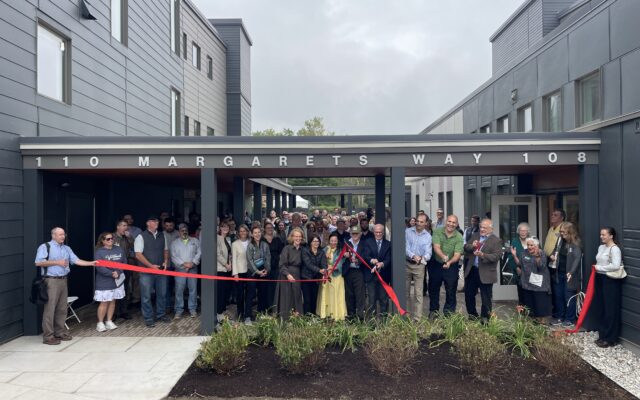Persistently low vacancy rates make economic growth harder, solving homelessness virtually impossible
FOR IMMEDIATE RELEASE: October 28, 2024
CONTACT: Lisa Patlis, (802) 861-3814
Colchester, Vermont – At the site of a former dormitory converted into affordable apartments, housing leaders and local officials released the annual Building Homes Together campaign scorecard documenting the number of homes and apartments created throughout Chittenden County in 2023.
The data showed continued housing production shortages – especially those which are affordable – as vacancy rates hover around 1%. In 2023, 720 new homes and apartments were constructed, with 125 of them permanently affordable. Both fall far short of the respective 1,000 and 250 unit targets.
“Building Homes Together has always taken a long-term view that we need to sustain housing development year after year,” said Charlie Baker, Executive Director of the Chittenden County Regional Planning Commission, one of the three Building Homes Together campaign-leading organizations. “Failing to meet targets means it’ll just take us longer to get to healthier communities and a healthy housing market. We’re thankful for land use and regulatory reforms passed by the Legislature the last few years and the actions on the local level to help increase housing but we all need to do more – supporting new housing, decreasing permitting barriers, and funding affordable housing production.”
With more than one-third of the jobs in the State in the county, the lack of housing in Chittenden County threatens Vermont’s economic health. Employers are finding it increasingly challenging to attract and retain employees due to the lack of housing availability, and an estimated 33,500 workers commute to Chittenden County jobs from other regions.
“To make our communities and economy function, everyone knows we need more housing,” echoed Nancy Owens, President of Evernorth. “I applaud the regulatory reforms; we can do more. I appreciate the funding made available to make housing affordable; we must do more. And lastly, I’m heartened by the increased awareness that housing is a public benefit – but we must do more to change our culture to embrace it and advocate for changes in our communities.”
Housing costs have been significantly impacted by both the cost of materials and labor, and by high interest rates. With constrained availability and increased costs, rents rose by almost 5% last year in Chittenden County (home sales prices also increased by 5%). That resulted in over half of renters being “rent burdened” or paying more than 30% of their income on housing, and waitlists growing for subsidized housing in the region: Cathedral Square counts 1,296 on their list, the Burlington Housing Authority has 1,127 and Champlain Housing Trust measures their list in months – it takes 15 months on average from time of application to time of a lease signing.
“When we started this campaign eight years ago, we called on the State to invest in more housing. That resulted in the Housing for All bond issued by the State, which at the time was the largest investment in housing in the state’s history,” recalled Michael Monte, CEO of Champlain Housing Trust, the third partner in the Building Homes Together campaign. “Since then, federal Covid relief and recovery funds have allowed us to invest more significantly, and we’re seeing housing being built in Shelburne, Burlington, here in Colchester, Winooski, Hinesburg and elsewhere as result. With so many people unhoused, with a continued 1% vacancy rate, we must continue this level of investment for several more years if we’re going to make progress.”
The annual scorecard is created from data collected from all of the municipalities in Chittenden County to tally the number of completed homes, condominiums, and apartments. It is compared with data from recent years to provide a visual trend of the housing development trends.
For more information on the Building Homes Together campaign, visit: https://www.ecosproject.com/building-homes-together.




